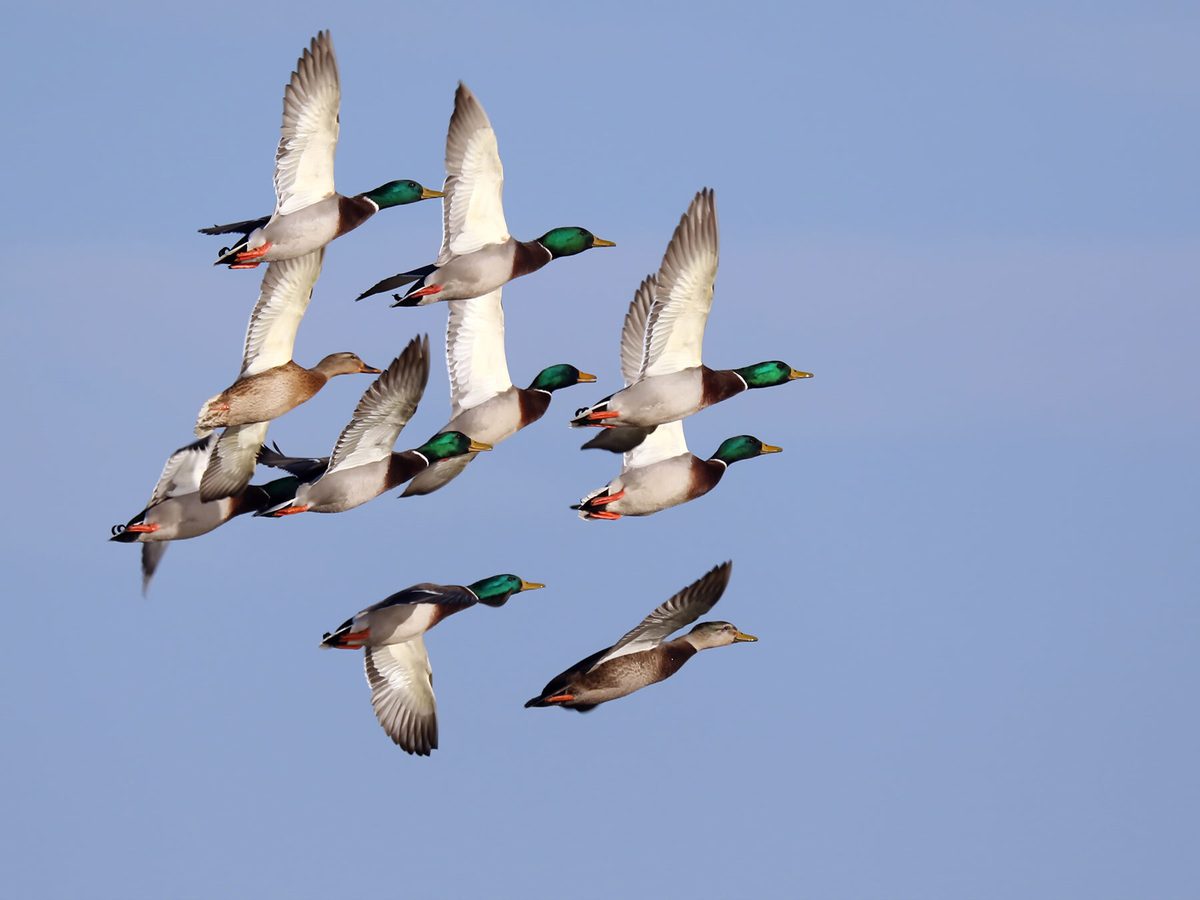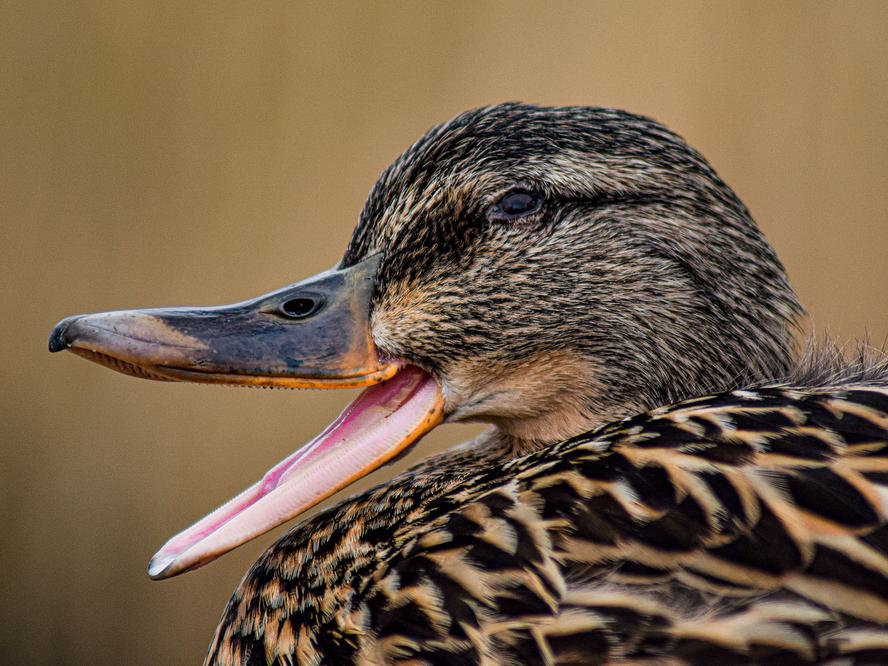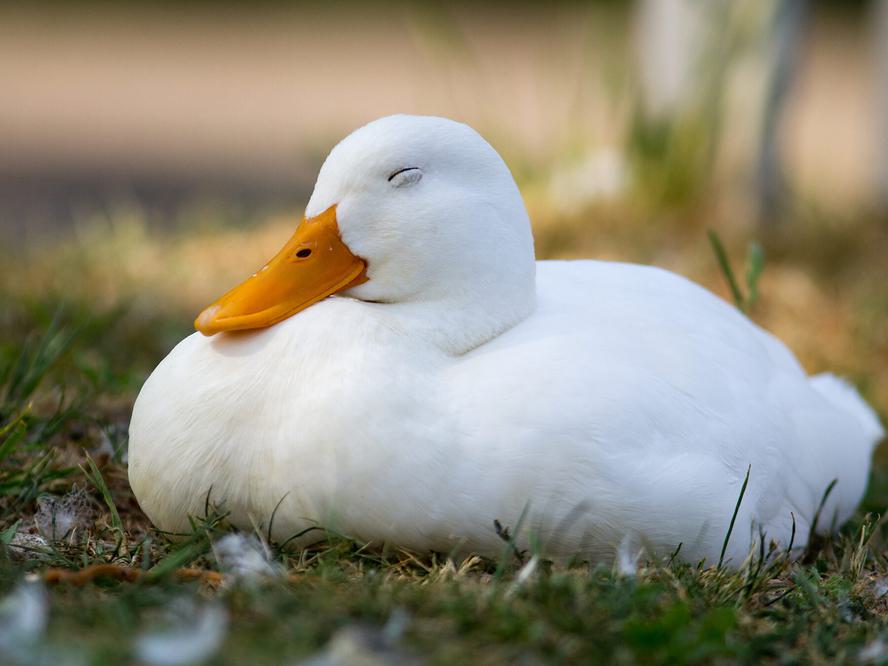Jump to Section
Do Ducks Migrate (All You Need To Know)
Last updated: 16 January 2022

Ducks belong to the Anatidae family, which contains some 174 species spread across 43 genera. With their broad and stout body, large beaks and webbed feet, ducks are a common and recognisable sight throughout the world. Ducks are probably best-known for their antics on water, so it's a compelling question to ask: do ducks migrate?
Though ducks are primarily associated with the water, many are strong flyers that migrate huge distances during winter. The Garganey duck is one such example that migrates from its Northern and Central European breeding grounds all the way to South Africa and India. Mallards in North America have been found to migrate over 700 miles (1,100km) south during winter.
As it happens, ducks are confident on both the land, sea and air! Some species, such as the Shelduck, can fly at altitudes of 17,000 feet where the air temperature is well below -15C. Ducks are pretty well-adapted to their generally colder habitats, but still, many do prefer to migrate to warmer wintering grounds during the colder months.
Read on to learn more about the migration behaviours of various ducks!

Common Shelduck taking off from the water
When do ducks migrate?
In Northern and Central Europe and North America, ducks tend to migrate at the end of the summer, around September, but possibly as late as October on a mild winter. Ducks in Siberia or the Palearctic might migrate as early as August.
Most ducks return to their breeding grounds as early as April, but March or May is more common. It does depend on the season, though - some ducks, like Mallards, may even choose to not migrate at all on a particularly mild winter.
Do all ducks migrate?
Many species of ducks in the upper Northern Hemisphere are at least partially migratory, leaving their breeding grounds at the end of a typical summer and returning at the start of spring. Others remain residents in their host countries and don’t migrate at all.
The Mallard is one such example of a duck that may or may not always migrate. Not all British or North American Mallards migrate, but those that do tend to leave in September and move to the Mediterranean or the Middle East, or the Southern US and Central America. The ornate Mandarin duck also doesn’t migrate from the UK, which is quite surprising given that many of its hardier cousins choose to migrate!

A flock of Mallards in flight together
Most Wigeons migrate - the Eurasian Wigeon is a frequent summer visitor in much of Central Europe, departing its cold Scandinavian and Siberian breeding grounds, though many end up as far south as East, West and Central Africa. The Eurasian teal is another example of a North European duck that heads south in winter, with some ending up much further south than others.
Many pintail ducks are also strong migrants and excellent flyers - one Northern Pintail is reported to have completed a journey of some 3,000 kilometres (1,864 miles) non-stop whilst migrating. Many end up in Sub Saharan Africa, South Africa and Asia, with some Russian populations ending up in Japan and China.
Shoveller ducks, including the Northern Shoveller, are also strong migrants, with European inhabitants flying to Africa and South Asia and North American inhabitants heading to Central and South America.

Northern Shoveler (Anas clypeata) male taking off from a lake
Perhaps the most prolific migrating duck is the Garganey. Whilst many ducks are only partially migratory, the Garganey is a very strong migrant, and more or less the entire European and Palearctic population migrates many thousands of miles to South Africa in India.
Ducks are flexible birds and have flexible migration behaviours to match. Most can handle the cold very well, so they generally don’t need to migrate as far as they do. Migration may just be a matter of preference rather than survival.

Close up of a male Garganey (Spatula querquedula) in breeding plumage
Where do ducks migrate?
In the Northern Hemisphere, ducks tend to migrate from Central and Northern Europe to either the Mediterranean (e.g. Mallards) or Africa and the Middle-East (e.g. teals and wigeons). Some fly all the way to South Africa (e.g. the Garganey).
Ducks distributed very far north, e.g. in Siberia or the Palearctic, might just fly as far as Central and Western Europe (e.g. the Pochard and Long-tailed duck).
In North America, both the US and Canada, some ducks move just a few hundred miles south in winter (including Mallards). Mergansers tend to move southwest in winter. Several North American teals can end up in Central and South America in winter, as is also the case with some Whistling ducks.
How far do ducks migrate?
Most ducks migrate just as far as they need to in order to find warmer roosting sites and food. In many cases, this might take them just a few hundred miles, if they migrate at all. For example, some ducks distributed across the subarctic regions and Scandinavia end up in Scotland - not exactly a holiday in the sun!
Longer distance travellers include Mallards which can fly for some 800 miles (1287km) without stopping. Northern pintails breed across much of northern Europe and the Palearctic but head all the way to the equator in winter - a journey that can exceed 5,000 km in total!

A flock of Northern Pintails and Mallards migrating from Canada
Why do some ducks not migrate?
Ducks, like many other migratory birds, are not always wholly committed to migration. They only migrate if the conditions require them to do so, primarily because they can avoid cold weather and food shortages by moving south.
After all, ducks are equipped with the ability of flight and nabbing a free holiday in Africa, Asia, South America or somewhere in the Mediterranean is free for them! Whilst many ducks are well-adapted to cold environments, they still choose to migrate. Migration for ducks may be a case of preference rather than survival - they enjoy their time in the sun, where food and shelter are plentiful.
Where do ducks go in the winter?
Ducks may or may not migrate in the winter - it depends on the species and region. Ducks who are content with their environment tend to stay put, finding a warm roosting site near a lakeside, river or coastline. Other ducks will simply fly inland where it’s warmer and marginally sheltered.
Migratory ducks usually fly south in the winter, seeking out warmer regions in South and Central America, Asia, Africa and Southern Europe.

Common Teal duck resting on ice during winter
Can ducks survive in the winter?
Many species of ducks are incredibly hardy and well-adapted to the cold. Their thick, water-repellent down and dense fat help insulate them from freezing temperatures. Duck down is even covered in an insulative oil that helps keep them waterproof.
There are several species of duck that live in arctic and Palearctic regions, including the Long-tailed duck and the Spectacled, King, Stellers and common eider ducks. These are amongst the hardiest birds on the planet.
Do ducks come back to the same place every year?
Ducks have a strong breeding ground affinity, meaning they try to return to the same sites year after year. Whilst ducks are not commonly known for their sense of direction and navigational abilities, they’re excellent at following navigational cues that direct them back home after winter.
Whilst most ducks are not monogamous, they still form strong social bonds with their flock with whom they often migrate. Breeding flocks will often return to the exact same breeding grounds each year.

Migratory Eurasian Wigeon (Anas penelope) ducks leaving in autumn
Do UK ducks migrate?
There are around 22 species of ducks that frequent the UK throughout the year. Many of these ducks are residents, meaning they stay here all year round, whereas others are immigrants or migrants.
The well-known Mallard is one such duck that may either remain a resident in the UK or migrate to Southern Europe and the Mediterranean. Other Mallards arrive on UK shores from elsewhere. The Tufted duck is primarily a resident in the UK and non-migratory. Wigeons, Gadwalls, pintails and some teals also spend winter in the UK, though others may continue on down south towards Africa and the Middle East.

A male and female Gadwall
Do ducks migrate south?
Where ducks migrate, they usually choose to migrate south. The closer to the equator they get, the hotter it is. It’s not just temperature that drives migration, though, but also food abundance and preference.
When do ducks migrate north?
Ducks do not migrate north, only if they’re travelling from a southerly coastal region to a slightly more northerly in-land region that is still warmer and more food abundant. Ducks fly back north after winter, which may occur as early as March.

Ring-necked Ducks in flight during migration
Do ducks migrate by flying?
Ducks do indeed migrate by flying. Whilst they’re usually sighted swimming on the water or waddling on dry land, many ducks are powerful flyers that are capable of long-distance flight.
During migration, many species of ducks fly at high altitudes of several thousand feet - air temperatures at high altitudes can drop towards -20C!
For much of their journey, ducks do not stop to take a break. Mallards are known to complete 800-mile migration trips without a break, for example. In fact, many waterfowl and members of the Anatidae family are superbly strong flyers that are capable of high-stamina long-distance travel.
On this page
- When do ducks migrate?
- Do all ducks migrate?
- Where do ducks migrate?
- How far do ducks migrate?
- Why do some ducks not migrate?
- Where do ducks go in the winter?
- Can ducks survive in the winter?
- Do ducks come back to the same place every year?
- Do UK ducks migrate?
- Do ducks migrate south?
- When do ducks migrate north?
- Do ducks migrate by flying?











